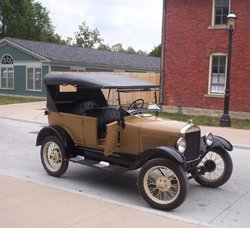Ford Model T
|
|
Missing image 1908_Ford_Model_T.jpg 1908 Ford Model T advertisement |
 Ford Model T used for giving tourist rides at Greenfield Village |
Missing image 1925.ford.model.t.arp.750pix.jpg 1925 Ford “New Model” T Tudor Sedan |
The Model T (colloquially known as the Tin Lizzie and the Flivver) was an automobile produced by Henry Ford's Ford Motor Company from 1908 through 1928. The first production Model T was built on September 27, 1908 at the Piquette Plant in Detroit, Michigan. Cars built before 1919 are classed as veteran cars and later models vintage cars.
There were several cars produced or prototyped by Henry Ford from the founding of the company in 1903 until the Model T came along. Although he started at the Model A, there were not 19 production models; some were only prototypes. The production model immediately before the Model T was the Ford Model S [1] (http://www.ritzsite.net/FORD_1/05_eford.htm), an upgraded version of the company's largest success to that point, the Model N. For some reason, the follow-on was the Model A and not the Model U.
| Contents |
Characteristics
The Ford Model T car was designed by Henry Ford, Charles Harolde Wills and two Hungarian emigrants named József Galamb and Jenő Farkas. The revolutionary Model T factory assembly line system was devised mostly by Charles Sorensen and Charles Lewis.1 The Model T had 177 in³ (2.9 L) 4 cylinder motor in a block producing 20 horsepower (15 kW) for a top speed of 45 mph (72 km/h). The engine had side valves and 3 main bearings. Recent accounts credit the default-configuration Model T with fuel economy on the order of 25 to 30 miles per gallon.
Production
Ford's Piquette plant could not keep up with demand for the Model T and only 11 cars were built there during the first full month of production. In 1910, after assembling nearly 12,000 Model T's, Henry Ford moved the company to the new Highland Park complex. The Model T was the first automobile mass produced on assembly lines with completely interchangeable parts, marketed to the middle class. To speed assembly, between 1915 and 1925 it was only available in one color, black, as black paint dried the fastest; Henry Ford is reputed to have made the statement "Any customer can have a car painted any color that he wants so long as it is black." Model Ts in different colors were produced from 1908 to 1914, and then again from 1926 to 1927.
By 1914, the assembly process for the Model T had been so streamlined it took only 93 minutes to assemble a car. That year Ford produced more cars than all other automakers combined. The Model T was a great commercial success, and for years in the late 1910s and early 1920s it was estimated that more than half of all motorcars in existence in the world were Model T Fords. In fact, it was so successful that Ford did not purchase any advertising between 1917 and 1923; in total, more than 15 million Model Ts were manufactured, more than any other model of automobile for almost a century. This record has now been surpassed by the Volkswagen Beetle, and the Toyota Corolla and Ford F-Series nameplates have both sold more.
It was sold in the beginning at a price of $850 when competing cars often cost $2000-$3000. By the 1920s the price had fallen to $300 (about $3,000 in 2004 inflation-adjusted dollars) because of increasing efficiencies of assembly line technique and volume.
On May 27, 1927, Ford Motor Company stopped manufacturing Model T cars. However Model T motors continued to be produced until August 4, 1941. Almost 170,000 motors were built after car production ceased. Many Model T parts are still manufactured today, particularly fibreglass replicas of their distinctive bodies, which are popular for T-bucket style hot rods (as immortalized in the Jan and Dean surf music song, "Bucket T", which was later recorded by The Who).
Notes
Note 1: First hand account of Charles Sorensen from his autobiography, My Forty Years with Ford (1956)[2] (http://www.eyewitnesstohistory.com/ford.htm)
See also
External links
- Model T Ford Club of America (http://www.mtfca.com/)
- Automotive History: The Model T (http://www.hfmgv.org/exhibits/showroom/1908/model.t.html)de:Tin Lizzy

